 W
WThe list of historical harbour cranes includes historical harbour cranes from the Middle Ages to the introduction of metal cranes in the Industrial Revolution during the 19th century. Modern reconstructions are also listed.
 W
WAjax is a floating crane built to move and install the canal locks and other large parts of the Panama canal. Ajax also helped in ship repairs and clearing the canal as needed. Ajax and her identical sister crane, the Hercules, were the largest floating cranes at time of completion, able to install the massive Panama Canal locks. Ajax could lift a maximum of 250 tons to a height of 21 feet, with a close reach. At Ajax's far reach she could lift a maximum of 100 tons. Ajax and Hercules were built by Deutsche Maschinenbau AG (1910-1977) . After the Ajax and Hercules, Deutsche Maschinenbau AG later made the Langer Heinrich, or Long Henry in 1915, in use for 100 years.
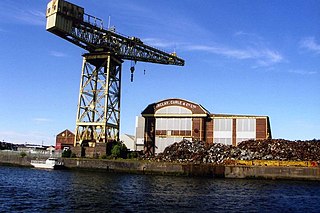 W
WThe Barclay Curle Crane is a disused Titan or giant cantilever crane at the Barclay Curle shipyard at Whiteinch, Glasgow, Scotland.
 W
WThe Douglas Breakwater Crane Railway was a massive self-propelled steam block-setting crane that ran the length of the original breakwater at Douglas, also used for the loading and unloading of vessels.
 W
WA crane vessel, crane ship or floating crane is a ship with a crane specialized in lifting heavy loads. The largest crane vessels are used for offshore construction. Conventional monohulls are used, but the largest crane vessels are often catamaran or semi-submersible types as they have increased stability. On a sheerleg crane, the crane is fixed and cannot rotate, and the vessel therefore is manoeuvered to place loads. As of 2019, the largest crane vessel in the world is the CNOOC Limited owned Lanjing, having 3 cranes of capacities 7500 tonnes, 4000 tonnes and 1600 tonnes.
 W
WDerrick Boat No. 8, also known as DB 8, is a historic floating derrick located at Oswego, Oswego County, New York. It was built in 1927, and it is one of the few surviving steam-powered floating derricks to have worked on the New York State Barge Canal. It has a 75 foot by 28 foot hull composed of both riveted and welded heavy steel plate. The site of the vessel's caretaker is the H. Lee White Marine Museum.
 W
WA Fairbairn crane is a type of crane of an 'improved design', patented in 1850 by Sir William Fairbairn. There are numerous hand-powered versions around the world and one surviving steam-powered example in Bristol Docks, England.
 W
WThe Fairfield Titan was a giant cantilever crane at BAE Systems' Govan shipyard, and the largest such crane on the River Clyde until it was demolished in 2007.
 W
WThe Finnieston Crane or Stobcross Crane is a disused giant cantilever crane in the centre of Glasgow, Scotland. It is no longer operational, but is retained as a symbol of the city's engineering heritage. The crane was used for loading cargo, in particular steam locomotives, onto ships to be exported around the world.
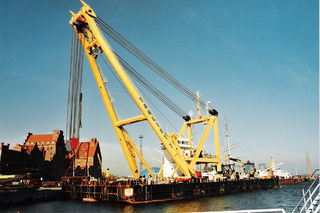 W
WA floating sheerleg is a floating water vessel with a crane built on shear legs. Unlike other types of crane vessel, it is not capable of rotating its crane independently of its hull.
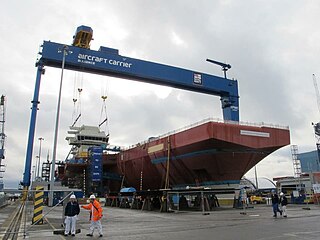 W
WGoliath is a crane in Rosyth Dockyard, Scotland, with a lift capacity of 1,000 tonnes, the largest in Britain.
 W
WTitan, better known by its former nickname Herman the German, is a large floating crane currently serving in the Panama Canal Zone performing heavy lifts for lock maintenance. Prior to its move to Panama in 1996, the crane was based at the Long Beach Naval Shipyard from the end of World War II until the yard's closure in 1995. It was seized from the German Kriegsmarine following the end of World War II as part of war reparations. The crane was built by Demag Cranes AG as Schwimmkran nr. 1 in 1941 for the Kriegsmarine, where it had served in the Baltic Sea tending German U-boats. MMSI number: 374940000
 W
WThe Hog Island Cranes, located in Trenton, New Jersey, are two of twenty-eight locomotive steam gantry cranes built in 1917 by the McMyler-Interstate Company of Cleveland, Ohio for the Hog Island, Philadelphia shipyard. They aided in the American war effort in World War One, are representative of an important era of heavy lifting equipment, and played an important role in 20th century waterfront technology. The two cranes now in Trenton were sold as government surplus in 1930 to the city of Trenton for $5000, a fifth of the original cost, and were installed at the Trenton Marine Terminal in 1932.
 W
WThe James Watt Dock Crane is a giant cantilever crane situated at Greenock on the River Clyde.
 W
WUSS Kearsarge (BB-5), the lead ship of her class of pre-dreadnought battleships, was a United States Navy ship, named after the sloop-of-war Kearsarge. Her keel was laid down by the Newport News Shipbuilding Company of Virginia, on 30 June 1896. She was launched on 24 March 1898, sponsored by Mrs. Elizabeth Winslow, the wife of Rear Admiral Herbert Winslow, and commissioned on 20 February 1900.
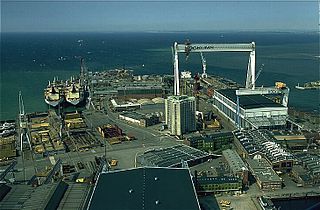 W
WThe Kockums Crane is a 138-metre (453 ft) high gantry crane in the Hyundai Heavy Industries shipyard in Ulsan, South Korea. It was originally used at the Kockums shipyard in Malmö, Sweden.
 W
WLanger Heinrich, or in English Long Henry, is a floating crane commissioned in 1915 for the Wilhelmshaven Imperial Shipyard in Wilhelmshaven, Germany and has been located in Genoa, Italy since 1997. At the time of completion she was the largest floating crane in the world, passing up the Ajax crane barge completed in 1914.
 W
WLeft Coast Lifter is a floating derrick barge or sheerleg which was built to assist in the eastern span replacement of the San Francisco–Oakland Bay Bridge. The barge carries a shear legs crane which is the largest barge crane ever used on the U.S. West Coast. The barge's name is taken from "Left Coast", a slang term for the West Coast of the United States.
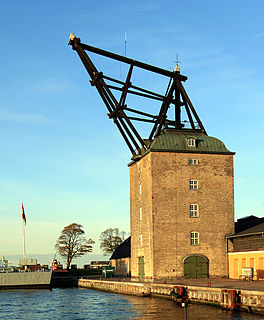 W
WMastekranen is an 18th-century masting sheer and present landmark on Holmen in Copenhagen, Denmark. It was designed by architect Philip de Lange and built in 1748–51 as part of the Royal Naval Shipyard at Holmen.
 W
WThe Rapaki steam crane was an historic boat in New Zealand.
 W
WSamson and Goliath are the twin shipbuilding gantry cranes situated at Queen's Island, Belfast, Northern Ireland. The cranes, which were named after the Biblical figures Samson and Goliath, dominate the Belfast skyline and are landmark structures of the city. Comparative newcomers to the city, the cranes rapidly came to symbolise Belfast in a way that no building or monument had hitherto done.
 W
WThe Schlachte Cranes were important to the port of Bremen as they enabled heavy loads to be moved off boats on the River Weser. The Schlachte became an important harbour for the city after silting prevented the use of the Balge as a harbour. Today, only the foundations of a 19th-century crane remain on the Weser waterfront.
 W
WTaisun is the name of the world's strongest crane which has a safe working load of 20,000 metric tons. Taisun is designed and built for the installation of very large modules in semi submersibles and FPSO projects and located at Yantai Raffles Shipyard in Yantai, Shandong Province, China. The crane holds the three heaviest lifts of all time: 20,133 metric tons, 17,100 tons and 14,000 tons.
 W
WTitan was a floating crane that operated in Sydney Harbour from 1919 until 1991. She was fabricated in Carlisle in the United Kingdom, then sent to Cockatoo Island Dockyard in Sydney for assembly, before entering service with the Royal Australian Navy (RAN).
 W
WTitan Clydebank is a 150-foot-high (46 m) cantilever crane at Clydebank, West Dunbartonshire, Scotland. It was designed to be used in the lifting of heavy equipment, such as engines and boilers, during the fitting-out of battleships and ocean liners at the John Brown & Company shipyard. It was also the world's first electrically powered cantilever crane, and the largest crane of its type at the time of its completion.
 W
WWeeks 533 is a 500-short-ton (454 t) capacity Clyde Iron Works model 52 barge-mounted crane which is the largest revolving floating crane on the East Coast of the United States. It was originally ordered for bridge construction and has since been used in several notable heavy lifts.